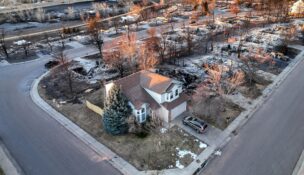Who Owns Colorado: Cracking Denver’s new zoning code
ColoradoBiz Staff //April 1, 2010//
For more than five years, Denver’s City Council, planning department and hundreds of volunteers and interested hangers-on have been crafting a new zoning code to replace the cobbled-together rule book that currently guides construction and land use in the city.
On June 21, the Denver City Council is scheduled to vote on whether to adopt the new regulations. While few people outside the building industry will ever read this document – besides insomniacs looking for a little late-night sleep aid – it will impact the city’s residents longer and greater than nearly any legislation the city has enacted in 50 years.
“It’s a big investment. It’s probably one of the most important things we can do to guide the growth of the city,” said Peter Park, manager of Denver’s Community Planning and Development department. “Having the new code is important to matching the vision of Blueprint Denver.”
The new code scraps nearly everything about the old version. It is the final puzzle piece in Blueprint Denver, a sprawling plan for the future of land use and transportation in the city that was adopted in 2002 with the overall goal of making sure that where we live, where we work and where we play (today and 20 years from now) are deliberately linked by appropriate modes of transportation.
But property owners in some parts of the city say the changes have them scrambling to develop their property under the old code at a time when banks have placed a kung fu grip on money and are loath to let it loose, particularly on speculative real estate projects, no matter how promising or well capitalized.
“The economy is what it is, and the changes to the zoning code exacerbates the problem for people who didn’t get developed already; it’s a timing issue,” said Larry Burgess, who has 23 buildings along Brighton Boulevard in an area just north of downtown Denver dubbed River North.
Blueprint Denver roughly breaks the city into what Park describes as areas of stability and areas of change. For purposes of zoning, a “stable” designation doesn’t necessarily mean there is no construction going on. Cherry Creek, Highlands and Park Hill are all considered areas of stability. The new code looks at these areas and assigns codes that help support the architectural style and general uses that are there. This seems pretty simple, but with zoning codes, even small changes can make a big difference. More about that later.
Then we have the areas of change. Almost all of downtown Denver, including Five Points and Brighton Boulevard north of Broadway and south of Interstate 70 are considered areas of change as are areas around major arteries like Colfax Avenue, Federal Boulevard, South Colorado Boulevard and 38th Street in the Highlands. These areas are slated for drastically different zoning codes that will match the development trends already under way and the kind of transportation alternatives planned for the area.
Perhaps the most drastically affected area is along Brighton Boulevard just north of Broadway. Once upon a time, in an economy that seems far, far away, River North was a promising frontier for developers looking for the next great neighborhood. Many of them took the “build it and they will come” approach, locking up parcels of land at top dollar and rezoning them one at a time into mixed-use Planned Unit Developments or PUDs.
“New developers came in during the high times and paid $35 per square foot, rezoned it to (residential mixed use), boosting the taxes and then didn’t do anything,” Burgess said. “If you’ll pay $35 per square foot, give me a call, I’ll sell you some land.”
He’s not getting many calls, and much of the land sits empty with plans for residential development on hold until banks loosen their grip on funds and federal regulators find the nerve to relax the stricter regulations that lenders are urged to follow. Still, with its proximity to downtown and long-term plans for light rail and other commuter friendly transportation modes, city planners feel this area will again be a hot spot for high-density living. In the meantime, property owners are struggling to hang on in a tough economy.
{pagebreak:Page 1}
“My take is, the vacancy rate is fairly significant for the demand. And it’s worse in commercial, industrial and office space,” Burgess said. “It makes you sit back and say, I’m just going to ride this one out. I don’t see the light at the end of the tunnel right now. I see a really tough time.”
Despite his struggle with the pending changes, Burgess and other developers recognize the shortcomings of the current zoning code. Originally written in the 1950s and expanded over decades by layers of new codes and hundreds of special districts – some as small as a few houses – it has become cumbersome to the point of confusion. In many areas of the city its tenets are contrary to current trends and future plans, requiring time-consuming and costly PUD rezoning.
“From an economic development standpoint, it takes out the uncertainty of zoning on a case by case basis,” Park said of the new code. “That’s what Denver has been doing for 50 years. Technically we have hundreds of zoning districts. “
Andre Pettigrew, executive director of the Denver Office of Economic Development , sympathizes with developers like Burgess, but he describes this lengthy, unpredictable process of rezoning individual lots to accommodate one project at a time as part of the problem faced by developers struggling to survive the economic downturn. He sees the new code as a catalyst to restart development, particularly in infill areas like River North.
“All of us who have had investments have seen an erosion of their wealth. We’re all sitting on pins and needles wondering will this hurt me or help me,” Pettigrew said. “The point I want to make is the opportunity now is how do we repurpose our infill redevelopment. What you’re seeing in River North now is an intense combination of residential, office and commercial coming together. I think the city has an opportunity in the review of this code to establish the new basis for development. Hopefully in the next 12 to 18 months the economy comes back and developers know where they stand.”
BACK TO THE FUTURE
While “areas of change” are getting a full-on zoning makeover, some parts of town dubbed “stable” are seeing subtle changes that will have a major effect on what can be built. Take, for example, Northwest Denver and the various neighborhoods that make up The Highlands and Sloans Lake. Since the end of Denver’s “Big Bang” almost 20 years ago when residents stopped expanding into the suburbs and started collapsing back into the center of the city, this area has progressively become the berg of choice for the middle-class.
Proximity to downtown, a mix of charming and affordable single- and multi-family housing, and hip retail districts blended into the grid of residential streets has steadily boosted popularity. Other areas fit this general description, but what has attracted developers is the delicate balance of lot size, land price and the all-important R2 zoning. Draped over the original 1950s code, this residential designation allows construction of attached single-family residences, or duplexes and triplexes.
This cost-effective architectural style has allowed builders to profitably erect two or three new homes on a lot that previously contained only one. This not only led to the rejuvenation of the housing stock, but it also increased the number of people living in the area, which in turn attracted more businesses – and a neighborhood is reborn. But a vocal minority of long-time residents complained that the new structures were out of scale with the existing homes.
“I think people in the community are concerned about keeping the context and architecture in line with the strong Northwest Denver tradition,” said Dan Pabon, a candidate for District 4 (NW Denver) State House of Representatives and a resident of the Highlands. “What we saw (as a result of) the previous code were extremely large duplex and triplex projects that overwhelmed the original architecture.”
Pabon added that he also talked to several property owners who invested in their home with the presumption that they could develop it down the line and use the money for retirement or to pay for a child’s college education. They are concerned that the zoning changes will diminish their property values. City planners say they recognize both sides of the argument and have gone back to the original code for an answer.
The new code does away with the R2 zoning and the duplexes that go with them, but in some areas it allows construction of a single-family home on a 3,000-square-foot lot and it allows “accessory dwelling units,” more popularly known as mother-in-law apartments. These were both allowed in the original code before the R2 overlay replaced them with other building styles. This revisiting of the past could create the next wave of new construction, though some developers are skeptical.
“No one likes change, but you’ve got to go with what’s allowed and adapt to the current situation,” said Don Gooden, an investor/developer with several projects in the Highlands neighborhoods. “Single-family homes could go, if the price is right.”
Pabon points out that messing with the zoning code is the “third rail of city processes” and ultimately not everyone will be happy. He said that in the last few months there’s been a lot of uncertainty about what can and can’t be done, and that uncertainty has created some anxiety, but the new code will fix some old problems, add predictability and create some new opportunities.
“I think that the (new) code found the right balance,” he said.
SIDEBAR:
BEFORE AND AFTER
Zoning codes dictate everything from how land can be used and what can be built on the land, to distances between buildings, required parking, open space between and around structures, even the general shape of a building. The new code moves toward a form-based criteria for determining what can be built, rather than just trying to fit into a box rule of height, floor area, set-backs etc.
Pictures of what planners are looking for will be published with the new code and serve as a tool for architects and builders to design structures that either fit what’s currently going on in the neighborhood or what city planners hope to see in the future. Of course, this is backed up with plenty of language that removes any subjectivity. For more information and the complete text of the proposed zoning code that the Denver City Council will vote on in June, visit: http://www.newcodedenver.org/
For a map of the various land uses outlined in Blueprint Denver, go to: http://www.denvergov.org/Portals/646/documents/Blueprint_Denver_plan%20map.pdf
{pagebreak:Page 2}






















